![]()
![]()
![]()
Use LEFT and RIGHT arrow keys to navigate between flashcards;
Use UP and DOWN arrow keys to flip the card;
H to show hint;
A reads text to speech;
21 Cards in this Set
- Front
- Back
|
Diameter of nerve
|
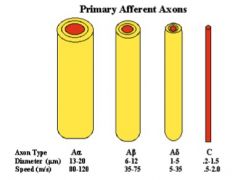
Conduction velocity increases with diameter. The internal resistance decreases when the diameter increases.
|
|
|
Length constant
|
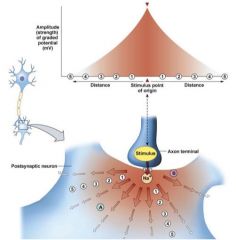
Any graded potential will decay as it travels away from the site of origin. The longer the length constant, the less the potential decays as it travels => for neurons, the longer the length constant the better.
|
|
|
Length constant equation
|

The larger the membrane resistance (fewer open channels - rm) the less likely a charge will escape from the cell. Neurons with smaller internal axial resistance (larger diameter - ri) the easier for a signal to flow
|
|
|
Time constant
|
How fast at a given point will the voltage change. How quickly does the action potential travel from threshold to peak ? The shorter the time = the better the conductance
|
|
|
Time Constant Equation
|
Time constant = Rm x Cm
Rm = membrane resistance (you want small so current can enter the cell quicker) Cm = membrane capacitance (you want less capacitance, this will allow less charge to be held and more current to enter the cell => shorter time constant) |
|
|
Myelin & Length constant
|
Increases length constant by:
- increasing nerve diameter - increasing membrane resistance and decreasing internal resistance |
|
|
Myelin & Time constant
|
Decreases time constant by:
- Decreasing capacitance (ability to hold a charge) - Increases internal membrane resistance, but not as great an effect |
|
|
Multiple Sclerosis
|
autoimmune disease that causes the degeneration of CNS myelin => reduced action potential rate and alterations in CNS function
|
|
|
Non decremental electrical conduction (unmyelinated)
|
threshold is reached => Na channels open => depolarize section of membrane (action potential) => domino effect where depolarizing travels down length of nerve
|
|
|
All or nothing
|
All action potentials must reach past a certain threshold, or there will be no signal conduction
|
|
|
Saltatory conduction
|
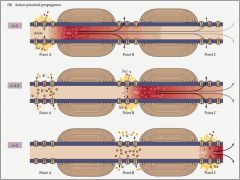
Myelin restricts transmembrane ion flow to nodes of ranvier (areas of high density voltage-sensitive Na channels). AP's only occur in these nodes, effectively skipping the signal along
|
|
|
Ganglia
|
collection of synapses , including cell bodies and nerve endings
|
|
|
Synaptic Transmission
|
action potential => voltage gated Ca channels open in pre-synaptic axon => vesicles release transmitter => cross synaptic cleft => bind to ion channel on postsynaptic membrane => change postsynaptic membrane to trigger response
|
|
|
Altering transmitter release
|
- Stopping transmitter release
- Ca-channel blockers - Altering level of extracellular Ca |
|
|
Post synaptic receptor antagonist
|
the antagonist can be a drug or ligand that has an affinity for the receptor but causes no reaction when bound to it
|
|
|
Transmitter degradation
|
acetylcholine - acetylcholinesterase
norepinephrine - monoamine oxidase (MAO) catechol-O-methyl transferase (COMT) - gegrades catecholamines (dopamine, epinephrine, and norepinephrine) |
|
|
Transmitter disposal
|
dopamine re-uptake inhibitor for the neurotransmitter dopamine by blocking the action of the dopamine transporter (DAT), effectively not uptaking the neurotransmitter
|
|
|
Excitatory Post- Synaptic Potential
|

presynaptic neurotransmitter opens ligand-gated NA channels causing a Na-ion influx and partial depolarization of the postsynaptic membrane. Makes the cell easier to excite - one is insufficient to generate an action potential
|
|
|
Inhibitory Post- Synaptic Potential
|

presynaptic neurotransmitter opens ligand-gated Cl channels causing a Cl-ion influx and partial hyperpolarization of the postsynaptic membrane. Makes the cell harder to excite
|
|
|
Spatial Summation
|
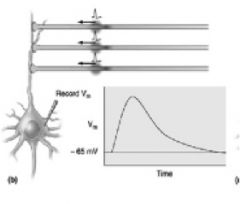
multiple axons innervate the same dendrite or cell body, can be excitatory or inhibitory
ENHANCED BY LONG LENGTH CONSTANT |
|
|
Temporal Summation
|
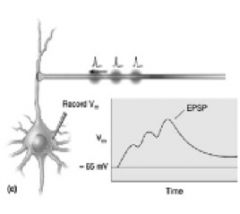
A train of action potentials from a single axon acts on the same dendrite or cell body, can be excitatory or inhibitory
ENHANCED BY LONG TIME CONSTANT |

